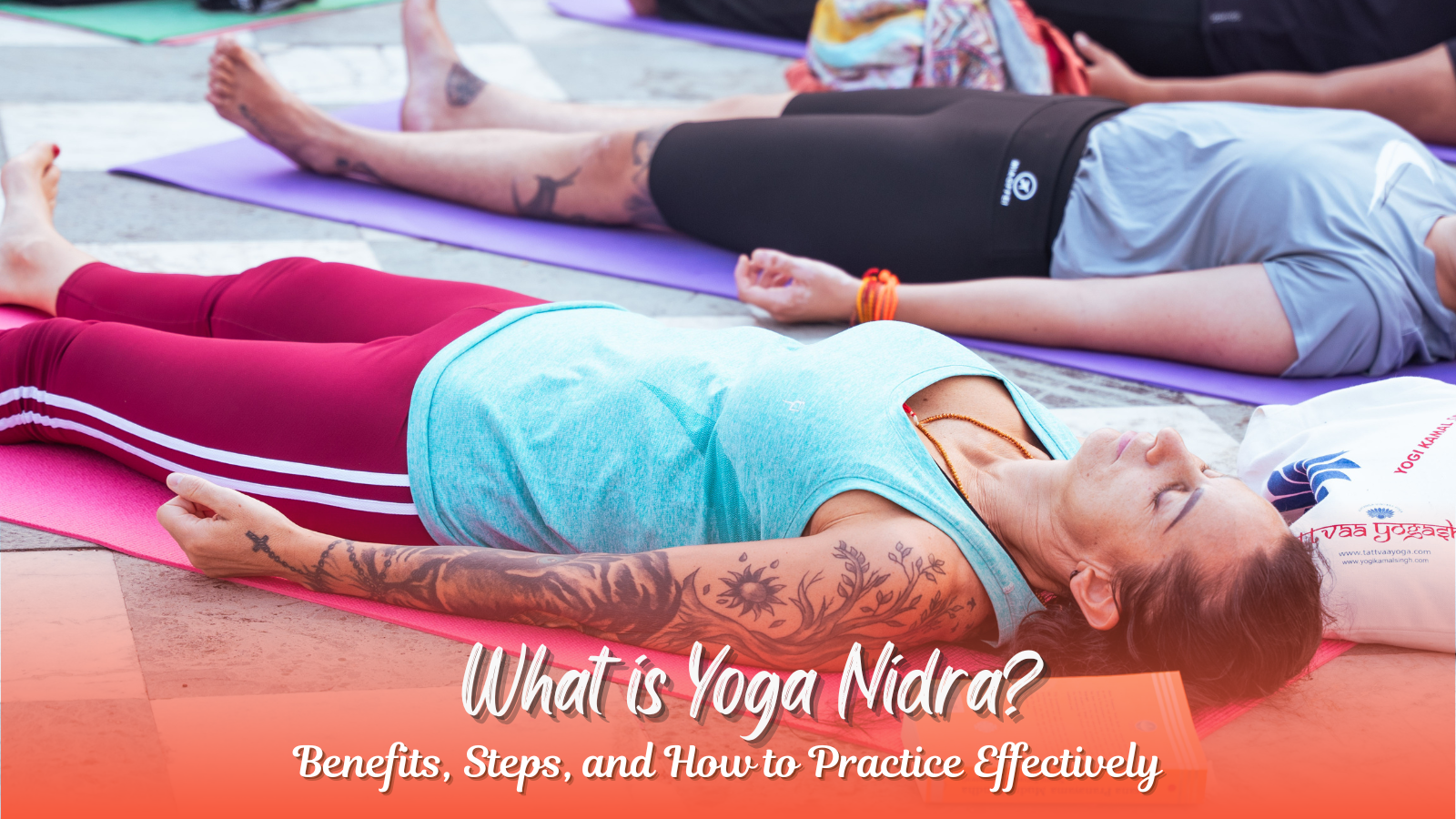What is Yoga Nidra? Benefits, Steps, and How to Practice Effectively
Yoga Nidra, which is literally known as “yogic sleep,” is a progressive approach towards meditation where the practitioner is led into a state of deep sleep with full consciousness. Practiced for centuries in the yogic tradition, Yoga Nidra is gaining immense popularity today, mainly because of its salutary effects upon one’s mental as well as physical health. This article aims to find out what Yoga Nidra is all about, what are its benefits, and how it can reduce stress, anxiety, and sleep disorders.
What is Yoga Nidra?
Yoga Nidra is a systematic form of guided meditation that induces a state between wakefulness and sleep. Unlike traditional meditation, which requires intense concentration, Yoga Nidra guides practitioners into deep relaxation effortlessly.
Yoga Nidra is a form of meditation that evokes deep relaxation by taking the practitioner through a body scan, breath awareness, and visualizations while still remaining conscious. It’s a practice wherein the body rests while the mind is awake; thus, there can be a conscious sleep or “yogic sleep.” It is guided meditation that would take you through different stages of relaxation and, therefore, let the practitioner feel a heightened awareness and deep release from tension.
The beauty of Yoga Nidra in India lies in its simplicity and accessibility. Unlike other meditation practices, Yoga Nidra can be practiced even by the very old and the very young, with or without any previous experience with yoga or meditation. It is generally done in a lying down position; therefore, the practice is accessible to people who may have mobility issues or possibly have difficulty staying seated for any length of time.
Yoga Nidra Techniques: How to Practice for Deep Relaxation
While the techniques may be different from one tradition or teacher to another, most forms of Yoga Nidra typically entail the following steps:
1. Setting an Intention (Sankalpa): This means that the practitioner sets up a positive intention or affirmation for the practice. This may indeed be a personal goal or maybe even a quality that he or she wants to cultivate. The Sankalpa serves as an anchorage throughout the session.
2. Body scan: He is guided to pay attention to every part of the body from the toes up to the crown of the head. This lets go of the physical tensions and develops a sense of relaxation.
3. Breath Awareness: It generally encompasses awareness about the breath itself, its normal rhythm, or calming the nervous system. Deep conscious breathing in this process helps in further relaxing and grounding of the mind.
4. Sensory Awareness and Visualization: One is guided to visualize images, sounds, or sensations that promote peacefulness and serenity. This can include peaceful landscapes, or gentle body sensations that bring a sense of relaxation deeper into the body.
5. Relaxation: After the body scan and breath awareness, one enters a deep relaxation state. The practitioner is asked to be relaxed yet alert. This is the magic of Yoga Nidra: when the body is fully relaxed, the mind knows.
6.Wake Up: Then it brings the practitioner out of that deep relaxed state, with him slowly being re-awakened into using his senses once again, making the body get back into being aware of all its elements. Yoga Nidra for Sleep
One of the more commonly attributed benefits of Yoga Nidra is to assist with the remedy for sleep improvement. It can activate the parasympathetic nervous system, which controls rest and digest functions. Therefore, it can be a tool that triggers deep rest and sleep. It can be useful for a person who is suffering from problems with sleeping or disturbed sleep pattern.
Unlike the usual meditation that may sometimes require mental discipline and concentration, Yoga Nidra can be used to relax without needing to silence the mind first, making it perfect for people who have been having a hard time quieting their minds at bedtime. One is likely to fall asleep faster, experience deeper sleep, and wake up fresher using Yoga Nidra for sleep.
Yoga Nidra Benefits: Why You Should Try It
7 Benefits of Yoga Nidra
Yoga Nidra is extremely beneficial to the body, mind, and spirit. Seven main benefits of practicing Yoga Nidra include the following.
1. Enhances Deep Relaxation & Reduces Stress
This is one method of deep relaxation for both the body and mind. Stress is reduced with such regular practice. Mental clarity increases, which results from having lower levels of the hormone responsible for causing stress-the cortisol.
2. Improves Sleep & Helps with Insomnia
The most requested benefit of the practice of Yoga Nidra is quality sleep. Deep relaxation has the capability to make both the body and mind ease out into a sleeping state. Moreover, it was also used naturally for those experiencing insomnia and not having good sleep quality. Various researches prove that those individuals who practice Yoga Nidra sleep much more quickly and also spend more time in the deeper, restorative phases of sleep.
3. Boosts Mental Clarity & Emotional Balance
Another common practice of Yoga Nidra is through anxiety yoga. The calming impact of Yoga Nidra overcomes the signs of anxiety and brings about emotional serenity. Therefore, with the aid of breath and body awareness as the anchor, anxious thoughts and feelings can be brought to stillness.
4. Supports Spiritual Growth & Self-Awareness
Regular practice of Yoga Nidra has been proven to enhance cognitive functions and mental clarity. It enhances focus and concentration, useful for work, studies, and daily activities. In fact, research has suggested that Yoga Nidra can enhance learning and memory retention.
5. Emotional Healing
It produces emotional relaxation due to the ability of Yoga Nidra that enables the participants to enter into a state from where sub-conscious emotions emerge up, and consequently, it gives a scope to emotional healing. It allows human beings to transcend through their traumatic past, frights, and other negative feelings.
6. Physical Relaxation
Yoga Nidra is an effect that sends one into deep physical relaxation. It helps in body rebalancing and healing. It can really benefit people suffering from chronic pain, tension, or fibromyalgia; it can help greatly with back pain.
7. Increased Self-Awareness
Through continuous practice, Yoga Nidra allows individuals to become more aware of themselves. It helps transcend the mind and emotions so that one may find out about his true self, desires, and intentions and hence spiritual growth and transformation.
How to Practice Yoga Nidra: Step-by-Step Guide
Yoga Nidra is an easy and highly relaxing practice for anyone, including beginners. Here’s how to practice Yoga Nidra in clear, step-by-step pointers:
1. Prepare Your Space
•Find a quiet, comfortable space free of distractions.
•Lie on your back with your body relaxed. One can use a yoga mat or soft surface but ensure you are well supported by your body.
•Put your arms alongside your body with palms facing upwards. The legs can be a little apart.
2. Set an Intention (Sankalpa)
• Set a positive, affirming intention or goal for your practice (this is referred to as a Sankalpa) prior to starting
• This may be something such as “I am calm and peaceful,” or “I trust my abilities.”
• Repeat the intention silently to yourself, allowing it to vibrate in the mind
3. Body Scan (Rotation of Consciousness)
• Scan the body starting at the toe and moving up through to the head.
•Consciously focus on relaxing the part of your body. Example: “I relax my toes… my feet… my ankles…” and so on.
•Focus on letting go of the tension in all parts of your body. Let the tension go with every breath.
4. Breath Awareness
•Switch to your breath. Notice how your breathing occurs naturally without trying to control your breath.
•Feel your body rise and fall with each breath.
•If your mind wanders, just gently bring your focus back to your breath.
5. Sensory Awareness
•Now, focus your attention on the senses. Take cognizance of the sounds that surround you, the sensations in your skin, the air on your body, and anything else.
•Just be aware of those sensations without judgment; let them deepen your state of relaxation.
6. Visualizations
•You are invited to imagine very peaceful, relaxing imagery. That could be a beach, some beautiful landscape, or something else that makes you feel relaxed.
•Engage all your senses with the imagery-see what you see, hear what you hear, feel what you feel, and smell what you smell in this peaceful setting.
7. Deep Relaxation (Effortless Awareness)
•Let yourself be in a state of deep relaxation, without needing to focus on or control anything.
•Aware of the quiet and serenity around you, let go of any thoughts or distractions. Simply experience the moment.
8. Return to Sankalpa
•At this point, go back to your Sankalpa (intention). Say it again, this time with complete faith and conviction, as if it were already happening.
•Allow this mantra to sink in.
9. Gradual Awakening
•Start slowly bringing your attention back to the present.
•Know your body, the sensations around you, and the room.
•Begin by gently wiggling your fingers and toes and stretch your body; when you feel ready, open your eyes slowly.
•Take a few moments to return from this deep relaxation to your waking life.
•Pause for a moment and assess how you feel. You might feel lighter, more centered, or peaceful.
•Be aware of it throughout your day.
Yoga Nidra vs. Meditation: What’s the Difference?
This meditation integrates the physical relaxation of yoga with the clarity of meditation. Through the concentration on each part of the body, breath, and visualization techniques, this meditative practice can bring the practitioner into a deeply relaxed yet fully aware state. It is through this meditation aspect that practitioners can then observe their thoughts and emotions in a nonattached manner, enhancing mindfulness and emotional balance.
Yoga Nidra Teacher Training and Certification
If you’re interested in becoming a Yoga Nidra instructor, pursuing Yoga Nidra teacher training or certification is an excellent path. Yoga Nidra teacher training courses are offered worldwide, with many yoga schools offering specialized training in the practice. The training focuses on the principles of Yoga Nidra, its therapeutic benefits, and how to guide others into a deep state of relaxation.
Yoga Nidra certification is the formal recognition of your ability to lead people through this practice. A Yoga Nidra teacher who is certified is a person best aware of techniques, benefits, and philosophical background that serve well in teaching to students.
Yoga Nidra Books and Resources
For those interested in diving deeper into the practice of Yoga Nidra, there are many books that delve into its techniques and benefits in-depth. Some popular titles include “Yoga Nidra: The Art of Transformational Sleep” by Richard Miller and “The Yoga Nidra Workbook” by Dr. Sonia A. Bera. These resources can offer insights into the theory behind Yoga Nidra and provide practical guidance for your personal practice.
YTT School in Rishikesh
If you want to take a much deeper journey into yoga, then Rishikesh is considered to be the spiritual capital of India and houses many great yoga teacher training schools. It is the perfect destination for a Yoga Nidra teacher training course where the students can learn the ancient practices amidst the peaceful Himalayan foothills.
Choosing the right school of Yoga in Rishikesh for Yoga Nidra training will provide you with a qualified instructor, a rich curriculum, and a genuine yogic experience. Many schools as part of their teacher training courses include Yoga Nidra and allow students to practice teaching it.
FAQs
1. What are the effects of Yoga Nidra?
The more you practice Yoga Nidra, the more your body relaxes into a deep state and your mind remains conscious, and so it allows one to deeply rest and rejuvenate just like a deep sleep without losing consciousness. Some even say that it helps improve mental clarity, reduces stress, and heals the body.
2. Why do I cry in Yoga Nidra?
Crying in Yoga Nidra may serve as an emotional release. Because in deeper relaxation and contact with the subconscious mind, unresolved emotions, memories, or traumas begin to surface in the process of healing. It can ultimately lead to higher emotional well-being.
3. Who is the god of Yoga Nidra?
In the yogic tradition, Savitri is often quoted as the goddess of Yoga Nidra, but being a manifestation of divine feminine energy, the practice transcends specific deities and is just a spiritual instrument for deep relaxation and self-realization.
4. Why is Yoga Nidra so powerful?
Yoga Nidra is powerful because it activates both the physical and mental aspects of relaxation. It allows practitioners to reach a deep state of consciousness in which the body heals, the mind rests, and emotional balance is restored. The practice also encourages self-awareness and spiritual growth, making it a transformative experience.
Yoga Nidra is a profound practice that offers various benefits for those seeking to ease stress, anxiety, and sleep disorders. Whether for relaxation, emotional healing, or self-discovery, practicing Yoga Nidra is excellent for overall development. By getting into this discipline, you’re going to end up with real deep relaxation along with mental lucidity and also emotional balance. If you consider teaching others this path to recovery and transformation, you may join a Yoga Nidra teacher training or take certification.
If you really want to dive deeply into the transformative power of yoga, consider attending a 200 Hour Yoga Teacher Training at an established Yoga Gurukul in Rishikesh. The program will give you the best yoga and meditation training but teaches you to live a more centered, mindful life. You shall discover the depth of your practice in a truthful and nurturing environment, be given the confidence and tools to succeed in all aspects of your life.


